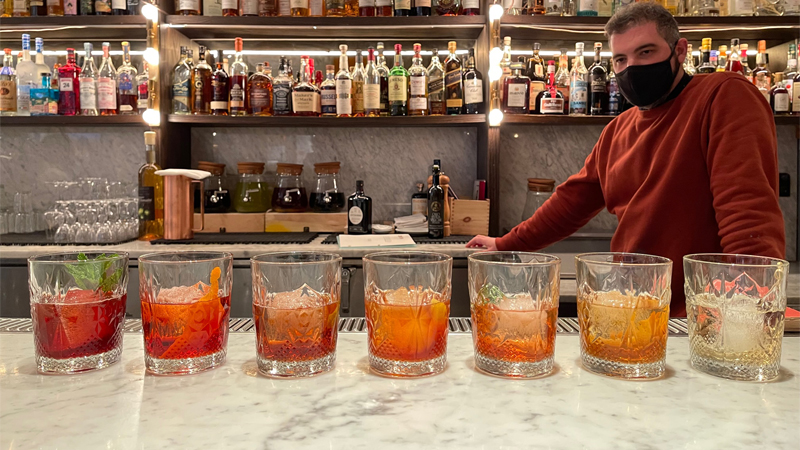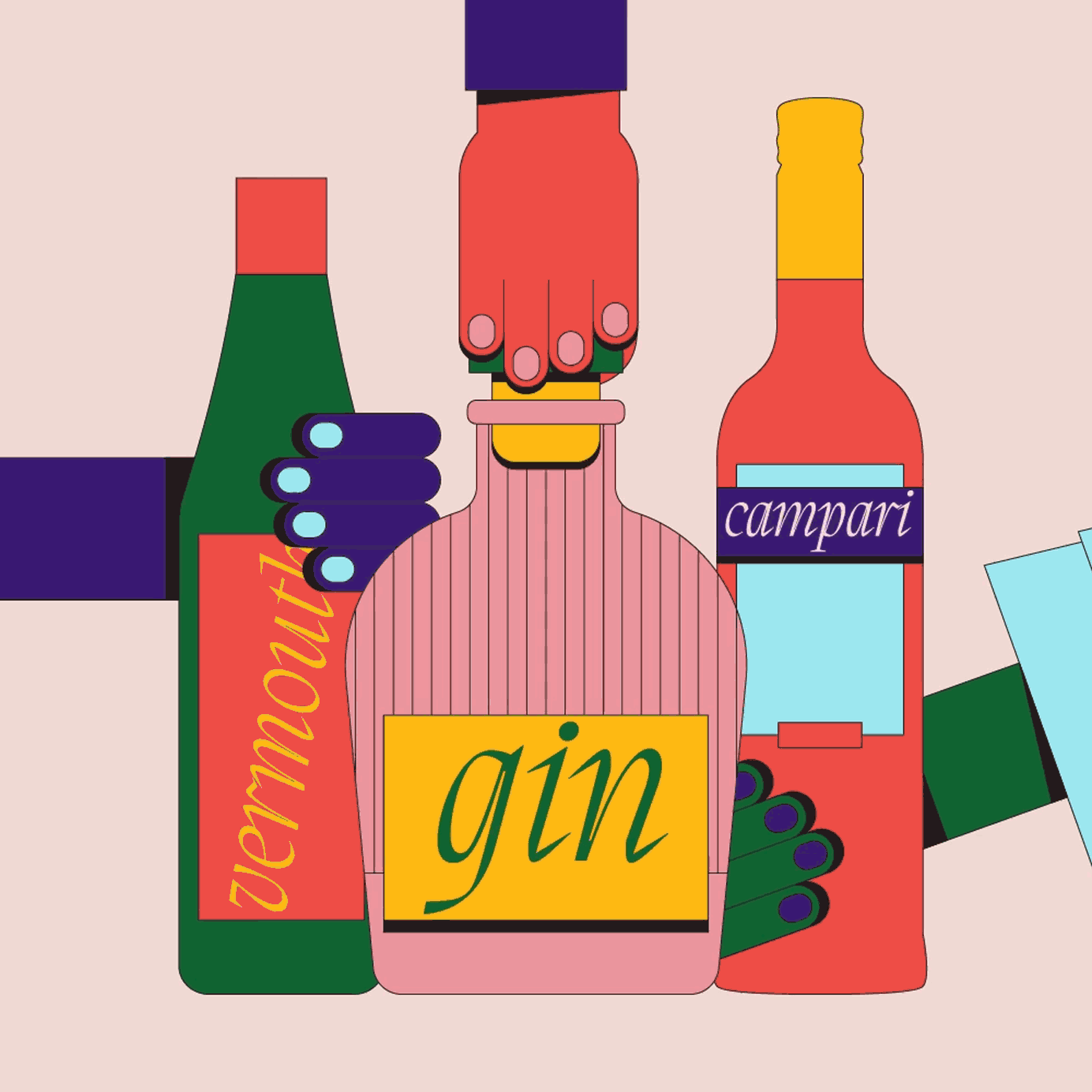It seems fitting that the Negroni, whose equal-parts, three-ingredient formula has inspired spirited riffs around the world, was born as a twist on another popular Italian drink. It was in 1919 when Count Camillo Negroni (1868-1933), a well-traveled aristocrat, gambler, former cowboy and fencing instructor, first asked Fosco Scarselli, the bartender at Café Casoni in Florence, for something stronger than the usual Americano. Scarselli replaced the soda water with gin and the resulting drink was christened in honor of the namesake count. Due to Prohibition and World War II, it wasn’t until the late 1940s and early 1950s when word of the Negroni traveled beyond Italy.
And since the early 21st century, the continued popularity of the Negroni, and the ubiquitous spritz, have helped Americans embrace the flavor of bitter in their drinks. In Drinks International’s 2022 annual survey of 100 of the world’s top bars, after eight years in its shadow, the Negroni finally surpassed the Old Fashioned as the best-selling classic cocktail. There’s beauty in the Negroni’s simplicity, and its Italian heritage and vibrant red hue inherently signal a sense of sophistication with a transportive effect of la dolce vita no matter where you are.
However, Rome-based cookbook author Katie Parla is quick to point out that, while the Negroni channels the essence of Italy, the drink itself isn’t that popular in its homeland beyond hotel bars that attract international tourists. “I think most drinkers have heard of it but many couldn’t tell you the ingredients and even fewer would order one because it is extremely strong compared to the other Italian classics,” says Parla. “With the rise of craft cocktail culture in Italy over the past decade, the Negroni has found new fame amongst drinkers in Italy, but I think that is linked to the fact many mixologists have seen its popularity abroad and are riffing off that.”
There are now endless variations of the Negroni taking up residence on cocktail menus in bars and restaurants around the world. From historic spins like the Sbagliato (swapping sparkling wine for gin) and the Boulevardier (bourbon, Campari, sweet vermouth) to modern classics like the Mezcal Negroni, Kingston Negroni (Jamaican rum, Campari, Carpano Antica Formula vermouth), and the Negroni Bianco (gin, Suze, Lillet Blanc). In addition, the presentation and flavor profiles are continually tweaked in alternate takes ranging from barrel-aged, fat-washed, and strawberry-infused to carbonated, bottled, and frozen. But are we at a place when a Negroni, in name, strays too far from the original template to risk diluting the spirit of the original drink and all it embodies? What is the tipping point when a Negroni is no longer a Negroni?
‘There Is No Negroni Without Campari’
At the Palizzi Social Club in South Philadelphia, general manager Guido Martelli shares that one-out-of-four drinks made on a weekend shift is its house Negroni, a traditional equal-parts blend of Beefeater gin, Campari, and Carpano Classico Rosso. On special occasions at the club, Martelli will break out its showstopping 5-gallon Negroni fountain (“That’s a lot of Negroni,” he says) where he makes a lighter Negroni punch for guests to serve themselves from the flowing centerpiece. Martelli and his team have done all kinds of seasonal variations on the Negroni, from a Negroni Sour in summer to a Boulevardier in the fall. “There is definitely a point when you’ve strayed too far from what makes a Negroni a Negroni,” says Martelli, who believes a classic Negroni should be dry and bittersweet with, ideally, a red bitter element. “I’m cautious to be too outspoken, because for every example I can think of, there’s a version that’s missing something,” he says. “If I say, ‘Every Negroni riff must include Campari,’ that would negate a White Negroni. And how could I argue against a White Negroni?”
When it comes to a Negroni, Matt Chavez, the bar manager at New York City’s Ci Siamo, will always reach for Campari. “First and foremost, I personally believe that a Negroni is only a Negroni if there is Campari in the mix,” he says. “That bitter element is very much the bones that compose the anatomy of the drink. Without Campari, a Negroni is a Negroni in name only.” The Ci Siamo Negroni, the neck-and-neck bestseller with its Martini, calls for Bordiga gin and Campari along with a splash of Cappellano Barolo Chinato and a split base of the bitter vermouth Punt e Mes and Volume Primo vermouth (specially made for Verona’s Archivio bar), resulting in a layered, nuanced, earthy, and floral Negroni that stands out without straying too far from the classic spec. “I think that the simplicity of it really adds to its popularity,” says Chavez. “The three-ingredient cocktail with that signature red glow really makes itself approachable on a consumer level. Even if someone doesn’t fully understand what Campari or vermouth are, you know what to expect when you order a Negroni. Its bittersweet flavor combination is both unique and incomparable.”
Matt Hranek, founder and editor of Wm Brown magazine and author of “The Negroni: A Love Affair with a Classic Cocktail,” recommends that the entry-level Negroni drinker start with the 1:1:1 formula and then modify it to suit your palate. His go-to Author’s Negroni calls for 1 and a quarter ounces each of Campari and gin with three-quarters of an ounce Punt e Mes. He prefers to stick with the classics when it comes to Negroni variations, calling out the Sbagliato (“It packs less of a punch and is refreshing on a summer day”) and the Mezcal Negroni (“I dig the smoky undertones the mezcal brings to the bitter and orange”). “There is a reason my Negroni book isn’t loaded with 150 variations and that’s because, in my opinion, there shouldn’t be that many,” he says. “You honestly can’t beat the OG recipe. Just like the Martini; don’t f*ck with it too much.
Variations on a Theme
At Bar Milano, a 70-seat bar and restaurant within the Flatiron outpost of NYC’s Eataly, before deciding on crispy saffron risotto or bone-in cotoletta, guests are presented with a menu of seven bespoke Negronis that are stirred and served from a stylish tableside trolley. Eataly Flatiron beverage director Randall Resitano takes what he calls a “mono-branded” approach, making each Negroni with spirits made by the same producer (or in some cases within the same portfolio as the featured brand). “The concept started with making a rainbow menu of Negronis,” says Resitano. “Negroni Bianco, Negroni Ambrato, Negroni Rosato, and at the end of it make our way to the classic red Negroni.” His eureka moment struck when he made a Negroni using gin, a red bitter, and vermouth all produced by the newly imported Friulian brand Fred Jerbis, from former perfume maker and bartender Federico Cremasco. Called the Fred Jerbis d’Oro, it’s a standout on the Negroni cart and Restiano’s personal favorite. “We were doing things with no regulations beyond let’s just make Negronis and see what happens. Using all Fred Jerbis resulted in the best Negroni I’ve had in a very long time,” he says. “After that, I knew I wanted to do the whole cart like that, using the idea of what grows together, goes together.”

Resitano freely admits that he takes a bit of poetic license with his definition of the Negroni. The Carpano Ambrato, garnished with a sprig of mint, uses the namesake brand’s Antica Formula vermouth and Botanic Bitter, but bold, black, and bitter Fernet-Branca tags in for gin. “Some things are not Negronis, but a fantasy of a Negroni,” he says. “But if it doesn’t have a bitter element, it’s not a Negroni. It needs to have three ingredients and equal parts. Maybe I’m old fashioned but that’s a thing I believe in.” It’s no surprise that the Tradizionale, the only Negroni on the list made with Campari, is the most popular offering. “People come to Eataly to have things done the way it’s supposed to be,” says Resitano. “They want spaghetti al pomodoro the way it’s supposed to be done, and they want a Negroni that’s red and made with Campari.”
Further downtown, the Italian-inspired Caffe Dante in Greenwich Village is a bar built on all things bittersweet, and its popular Negroni Sessions menu spotlights 13 inspired improvisations on a theme, ranging from a classic Negroni served on tap to a $65 vintage Negroni made with Plymouth gin, Cinzano Rosso vermouth, and Campari, all from the 1970s. Campari is featured throughout the menu, but they also utilize a number of other Italian red bitters such as Contratto, Luxardo, Martini & Rossi, and Cappelletti. And among the deep cuts you’ll find a Gingerbread Negroni with a base of spiced-butter-infused Santa Teresa rum and a Chocolate Negroni spiked with Tempus Fugit Crème de Cacao and a few dashes of chocolate bitters.
Enough is Enough, or the More the Merrier?
Just when it seems that a gingerbread Negroni is the closest the cocktail will get to revisiting the era of the “-ini” — when any drink served in an oversized V-glass was branded as a Martini variation — a recent Canadian campaign from Campbell’s Soup arguably pushes it over the edge. Promoting its line of low-sodium broths, the soup brand created a number of cocktail recipes that promised to turn “the usual into the deliciously unusual.” The campaign included a Thai Chicken Negroni, made with gin, Campari, sweet vermouth, and a half-ounce of Campbell’s Thai Chicken Broth chilled with ice cubes made from said broth. Capitalizing on the popularity of the drink, this borderline April Fools content was an extreme example of Negronis Gone Bad.
But Chavez holds out hope and is grateful that we have yet to see Martini-in-name-only riffs like the Lychee Negroni or Pornstar Negroni. “I think that old and new bartenders will continue to take liberties in using the term Negroni to describe drinks that somehow resemble the classic,” he says. “If the drink has elements of something bitter, something strong, and some form of fortified wine, I’m sure we’ll see it ‘oni-ed.’” The Ci Siamo bar manager has no doubt that the name Negroni will be attached to riffs for decades to come. “But as a purist, the Negroni will always set one type of expectation and check one specific box of satisfaction.”
